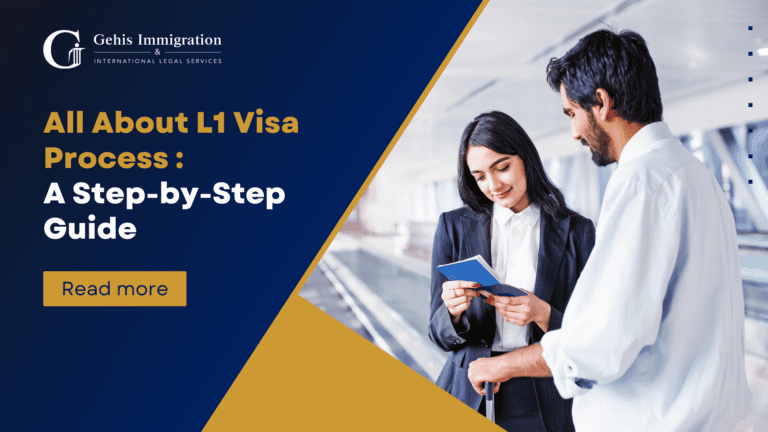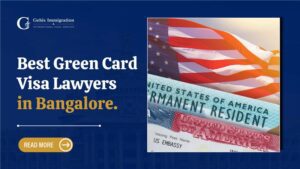All About L1 Visa Process a Step-by-Step Guide
The L1 visa is a tool for multinational companies, allowing them to transfer key employees from their overseas offices to their U.S. branches. This visa facilitates the exchange of talent, enabling businesses to maintain continuity and expertise across borders, which is essential for managing global operations efficiently.
There are two primary types of L1 visas: the L1A visa, designed for executives and managers, and the L1B visa, which is for employees with specialized knowledge. Both categories serve different purposes but are equally vital in supporting the smooth functioning of international corporations.
Understanding the L1 visa process is important for both employers and employees, as it involves meeting specific eligibility criteria and managing a multi-step application process. Knowing the nuances can help in the process, avoid potential delays, and ensure compliance with U.S. immigration regulations.
What is an L1 Visa?
The L1 visa is a nonimmigrant visa that allows multinational companies to transfer certain employees from their foreign offices to their U.S. branches. This visa is primarily used for individuals who hold key positions within the company, either as executives/managers (L1A) or employees with specialized knowledge (L1B). The L1 visa promotes the efficient management and operation of multinational businesses by enabling the temporary relocation of valuable personnel across borders.
Eligibility Criteria for Employers and Employees:
Employer Requirements:
The company must be engaged in international business, with offices or operations both outside and within the United States.
There must be a qualifying relationship between the U.S. and foreign offices, such as a parent company, branch, subsidiary, or affiliate relationship.
Employee Requirements:
The employee must have been employed with the foreign company for at least one continuous year within the last three years before applying for the L1 visa.
The employee must be entering the U.S. to take a managerial/executive role (L1A) or a role that requires specialized knowledge (L1B).
This visa is particularly beneficial for large corporations that need to maintain operational consistency and expertise across their global network, while also providing opportunities for employees to work in the U.S. temporarily.
Types of L1 Visas: L1A vs. L1B – US L1A Visa Process
The L1 visa is divided into two categories: L1A and L1B, each serving different purposes within multinational companies. The L1A visa is designed for executives and managers who hold key roles within the company. These individuals have significant decision-making authority, oversee major operations, or manage other employees within the organization. To qualify for the L1A visa, the employee must have worked in an executive or managerial capacity for at least one year within the last three years. The initial duration of the L1A visa is three years, with the possibility of extending it in two-year increments, allowing for a maximum stay of up to seven years.
On the other hand, the L1B visa is for employees with specialized knowledge critical to the company’s operations. Specialized knowledge refers to a deep understanding of the company’s products, services, proprietary systems, or advanced technical expertise that is not commonly available in the industry. L1B employees must demonstrate that their skills are essential to the success of the U.S. office. Like the L1A visa, the initial L1B visa duration is three years, but it can only be extended for an additional two years, with a maximum stay of up to five years. Both categories are vital in facilitating the smooth transfer of key employees within multinational companies, ensuring operational consistency and growth.
Step-by-Step US L1A Visa Process
The process for obtaining an L1 visa involves several steps that both the employer and the employee must follow to ensure compliance with U.S. immigration laws.
Step 1: Employer Eligibility and Documentation
The first step requires the employer to demonstrate eligibility. The company must provide proof of a qualifying relationship between the U.S. and the foreign entity, such as evidence of parent-subsidiary, affiliate, or branch status. The company must show that it operates on a multinational level, meaning there are business activities both in the U.S. and abroad.
Step 2: Employee Eligibility
Next, the employee’s eligibility must be verified. The employee must meet the basic qualifications, such as having worked for the foreign entity for at least one continuous year within the last three years. This step includes gathering documentation to prove the employee’s role, whether as an executive/manager (L1A) or a specialized knowledge worker (L1B).
Step 3: Filing the L1 Petition
The employer then files a Petition for a Nonimmigrant Worker on behalf of the employee, submitting it to U.S. Citizenship and Immigration Services (USCIS). This filing must be accompanied by supporting documentation, including proof of the employer’s eligibility, the employee’s qualifications, and other relevant documents. For larger companies, there is the option of filing a blanket L1 petition, which simplifies the process for multiple employees by pre-approving the company’s eligibility.
Step 4: Consular Processing (If Outside the U.S.)
If the employee is outside the U.S. at the time of application, they will need to go through consular processing. This involves scheduling a visa interview at the nearest U.S. consulate or embassy. The employee must prepare for the interview by bringing all required documentation, such as proof of employment and qualifications, and be ready to answer questions about their role within the company.
Step 5: Visa Approval and Travel to the U.S.
Once the visa is approved, the employee receives the L1 visa in their passport and can arrange to travel to the U.S. Upon arrival at the port of entry, the employee will go through an immigration inspection process where they must present their visa and other required documents.
Step 6: Post-Arrival Compliance
After entering the U.S., the employee must maintain their visa status by adhering to work restrictions and ensuring they continue working in the same role for the sponsoring employer. If any changes occur, such as a shift in job responsibilities or location, these changes must be reported to USCIS to avoid visa violations. Maintaining compliance is essential for avoiding any legal issues or disruptions to the employee’s stay in the U.S.
US L1A Visa Process Extensions and Renewals
L1 visa holders, whether under the L1A or L1B category, can extend their stay in the U.S. if they continue to meet the visa requirements. To request an extension, the employer must file a Form with U.S. Citizenship and Immigration Services (USCIS) before the initial visa period expires. The process requires submitting updated documentation proving the employee’s continued eligibility. For the L1A visa, the initial period is up to 3 years, with extensions granted in 2-year increments, allowing for a maximum stay of 7 years. For the L1B visa, the initial period is also 3 years, and extensions allow a total stay of up to 5 years.
The required documentation for extensions includes proof that both the employer and employee still meet the L1 visa criteria, evidence of the ongoing qualifying relationship between the U.S. and foreign offices, and updated employment contracts or job descriptions confirming the employee’s current role. The employee’s role must remain consistent with the L1A or L1B visa requirements.
Overstaying the authorized visa duration can lead to serious consequences. If an employee remains in the U.S. beyond their allowed stay without obtaining an extension, they risk facing penalties such as future ineligibility for U.S. visas, deportation, and removal proceedings. Overstaying can also lead to the accumulation of unlawful presence, which may result in a bar from re-entering the U.S. for up to 10 years. To avoid these issues, employers and employees need to request extensions on time and ensure compliance with visa regulations.
Benefits of the US L1A Visa Process
The L1 visa offers several advantages that make it an attractive option for multinational companies and employees. One of the benefits is that, unlike the H1B visa, the L1 visa is not subject to an annual cap. This means there is no limit on the number of L1 visas that can be issued each year, allowing companies to transfer employees as needed without worrying about numerical restrictions.
Another significant benefit is the dual intent feature, which allows L1 visa holders to apply for a green card while maintaining their nonimmigrant status. This flexibility enables L1 employees to pursue permanent residency in the U.S. without jeopardizing their visa status.
The L1 visa provides benefits for the employee’s family. The spouse and children of the L1 visa holder can apply for L2 visas, allowing them to accompany the primary visa holder to the U.S. The L2 spouse is eligible to apply for work authorization, granting them the opportunity to work in the U.S. during their stay. These combined benefits make the L1 visa a favorable option for multinational employees and their families seeking temporary relocation to the U.S. with the possibility of long-term settlement.
Transitioning from US L1A Visa Process to Permanent Residency
Transitioning from an L1 visa to permanent residency involves several steps and requires careful planning. For L1A visa holders, the EB1C category provides a direct way to obtain a green card. The EB-5 employment-based immigrant visa category specifically designs this visa for multinational executives and managers who are already in the U.S. on an L1A visa. It allows them to apply for permanent residency without the need for labor certification, expediting the process for qualifying individuals.
Documentation Required:
The timeline for transitioning to a green card can vary based on several factors, including processing times and the applicant’s specific circumstances. Generally, the process involves several stages:
The employer must file an Immigrant Petition for Alien Worker on behalf of the L1A visa holder. This form demonstrates that the employee meets the requirements for the EB1C category.
Required documentation includes proof of the executive or managerial role, evidence of the company’s multinational operations, and a detailed description of the employee’s job duties and accomplishments.
If the employee is already in the U.S., they can apply for Adjustment of Status once their priority date becomes current. This step changes their status from a nonimmigrant to a permanent resident.
Employer’s Role in Supporting the Green Card Application Process:
The employer plays a huge role in supporting the green card application process. They must provide detailed evidence of the employee’s role, the company’s organizational structure, and the multinational nature of the business. The employer must assist in preparing and submitting the necessary forms and supporting documents to USCIS. Their involvement is essential for verifying that the employee continues to meet the eligibility criteria for permanent residency.
Final Word – US L1A Visa Process
The L1 visa process involves several steps, including verifying employer and employee eligibility, filing the appropriate petitions, and managing extensions and renewals. The process demands careful planning and thorough preparation of documentation to ensure compliance with U.S. immigration regulations.
It is highly recommended that companies and employees managing the process seek professional legal assistance to streamline and facilitate each step effectively. Gehis Immigration and International Legal Services can provide invaluable support, leveraging our skills to help clients understand and meet visa requirements, file accurate petitions, and handle any issues that may arise. Engaging with a knowledgeable immigration law firm like Gehi’s can significantly enhance the chances of a smooth and successful L1 visa application, ensuring that both employers and employees can focus on their core activities with confidence.






